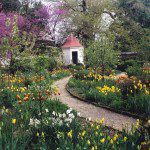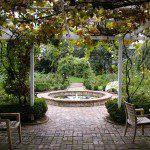79th Annual Historic Garden Week
By • June 29, 2012 0 1810

This is for people who wake up, head outside, take a deep breath and say, “I love the smell of mulch in the morning.”
This is for the poetic hearts who get smitten and blown away by the sight of rows upon rows of red and yellow tulips, gardens so beautifully arranged that they marry both art and history.
This is for the traveler who loves nothing better than to be embraced by the historic, as if every outing were a road map to an American Brigadoon.
In short, you don’t have to be a gardener to love gardens, you don’t have to be a researcher or a historian to want to drop by the homes of our Founding Fathers. Stop by at Mt. Vernon, Monticello, Montpelier and say hello again to George, Thomas and James and their kin, and yes, visit their gardens.
This is for you, this being the 9th Annual Historic Garden Week in Virginia, April 21 to 28, spread out to all the historic, elegant, spring-kissed, history-touched places, towns, homes, villages, cities and wayward inns and stopping points along old coach routes and battlefields, and forested acres of land for fox hunting and horse raising.
While we’re speaking in historic terms, a little history is in order. The Historic Garden Week is the offspring of the early members of the Garden Club of Virginia, who in 1929 wrote to their friends and suggested they go on a sort of “pilgrimage” of historic homes and gardens in Virginia, of which there are multitudes. The first tour lasted 11 days and produced a guidebook costing the grand sum of two dollars. As such projects sometimes go, the Historic Garden Week flowered, grew like dandelions do, lasted as the sturdiest of all-weather flowers, and was held annually ever since. There was a brief interruption during World War II when the Garden Club of Virginia sent help and money to England where folks were hard pressed to keep up their beloved gardens while under attack and preparing to invade Europe along with a few chaps from America.
This is the sort of thing that is a boon to the tourist industry of any state, because it encourages visitors to visit the whole state. This is a region and state where people for centuries have named their houses, it’s where homes aren’t just a numbered address but an identity as in the Manor or Oakwood, Edgewood, Poke and Woodlawn Farm, to name four Middleburg attractions on the tours.
To take in the whole of the Garden Week, you will tramp across battlefields from the Revolutionary War to the Civil War, visit mansions, plantations, villas, inns, presidential homes, churches and residences dating back to colonial days. You want history; you’ve got history.
In the interests of history, the Garden Club of Virginia and its members turn the proceeds from the tours that are part of Historic Garden Week into restoration projects, including Mount Vernon, Monticello and the grounds of the Executive Mansion in Richmond.
Nearby Old Town Alexandria and Arlington provide part of the tours of Historic Garden Week, which also include Albermarle County, Ashland, Chatam, Clark County, Danville, Eastern Shore, Franklin, Fredericksburg, Gloucester-Matthews, Harrisonburg, Lake Gaston-Bracey and Ebony, Lexington, Lynchburg, Martinsville, Middleburg and Upperville, Middlesex County, the Middle Peninsula, Newport News, Hampton, Norfolk, Northern Neck-Lancaster County, Orange County, Petersburg, Portsmouth, Richmond, the Ampthill/Wilson area, the Boulevard and Three Chops/Westhampton of Richmond, Roanoke, Staunton, Virginia Beach and Williamsburg.
The week will consist of more than 31 separate tours held over eight days, featuring 191 homes and private gardens, an army of 3,400 volunteers, and a reported 15 tons of mulch — in the morning and other times. All of this will be garnished, emblazoned, trumpeted and made as stunning and beautiful as a good-weather day at Eden by 2,000 floral arrangements and the presence of an estimated 5,730 tulips and other flowers, daffodils among them.
Close to home, Old Town Alexandria will take part in the Historic Garden Week on Saturday, April 21.
Old Town, with its weekly market, waterfront, city hall and Christ Church, cobbled streets, from where you can move right ahead to Mount Vernon, has history as its daily companion and can have the pace of colonial times.
In Alexandria, two gardens clubs have partnered with six additional properties, including a half-dozen townhouses and gardens dating back to the 18th and 19th centuries.
On the tour that day will be the following residences and gardens:
– The Capri House and Garden at 117 South Lee Street
– Mrs. Wright’s garden at 212 South Fairfax Street, archived by the Smithsonian
– The Spar’s House and garden at 206 Wolfe Street
– The Boteler’s house and garden at 320 South Lee Street
– Ms. Scarborough’s house and garden at 613 South Royal Street
– The Jankowski’s house and garden at 215 Jefferson Street
– The famous Lee-Fendal House Museum and Garden at 614 Oronoco Street at North Washington Street
– The Carlyle House Historic Park at 121 Fairfax Street
– Mount Vernon, which was also a restoration site of the Garden Club of Virginia
– Woodlawn, 9000 Richmond Highway
– Gunston Hall Plantation at 10709 Gunston Road in Mason Neck
Arlington will hold its portion of the garden week tour on April 24, emphasizing homes built to create neighborhoods that would become one Virginia’s first suburban communities.
While Mount Vernon is closer to D.C., it might also be interesting to visit Thomas Jefferson’s Monticello, where the observance of the garden week will include a two-hour tour of Jefferson’s revolutionary garden April 21 and April 23.
Also of note is the tour at Ashland, April 21, which the Ashland Garden Club redesigned after the August 2011 earthquake in Louisa County damaged its centerpiece property.
For additional information and schedules, visit www.vagardenweek.org or www.gcvirginia.org.
- Mt. Vernon Upper Garden. | Photo by Megan Lott



